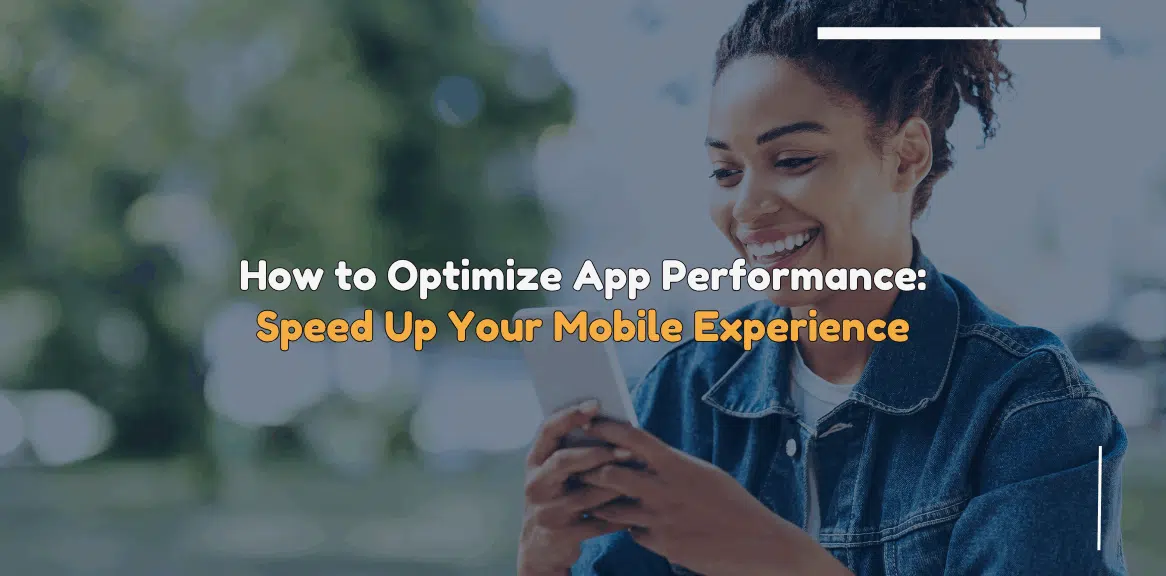The most aesthetically created application may frustrate users in case the application slows down, crashes, burns its batteries too fast, or takes too much time to start.
This is because one of the largest factors that affects the continued use of a mobile app includes the performance of the app, which can either cause them to keep using the application or even uninstall it soon after downloading.
In modern life, digital experiences are expected to be instant, smooth, and responsive, so the optimization of app performance is not only a technical enhancement but also a business necessity.
A quick app will make users stay active, generate good word of mouth, increase retention, and eventually result in increased ratings and conversions. When followed systematically, app performance improvement leads directly to higher user satisfaction and retention.
This blog describes why performance is important, how to make your app run with the greatest performance, and actions that can be taken by developers to provide a fast, smooth experience, regardless of the platform the user is using (iOS or Android).
Why App Performance Matters
The users develop a perception of your app in a few seconds of its utilization. When the app loads fast, it reacts immediately, and it feels natural as one goes through the screens, then the users have higher chances of having confidence with proceeding.
But a slow loading or slow scrolling definitely shows that the quality is low, even though the functionality of the app may be of value. Mobile users now demand that the apps be as fast and smooth as the native operating system experiences.
Ratings and reviews are directly affected by the performance of the app. Underperformance also tends to cause negative reviews, leading to poor presence in app stores.
Performance issues can add to the costs of servers, maintenance costs, and churn rates on the business side. Concisely, performance does not have imaginary effects, either in technical or commercial terms.
Start by Measuring Performance Instead of Guessing
You should know the points of bottling of your performance before making any changes. The most common mistake made by developers is to make everything optimal once, or to guess at which point the problem is. Rather, apply performance monitoring and profiling applications to gather actual data.
Android Studio Profiler, Xcode Instruments, framework-specific tools like Flutter DevTools or React Native Flipper, and others can be used to find slow functions, memory usage, long-lasting UI processes, slow network requests, and similar unseen bottlenecks.
Profiling will help you find out that your application is slow due to excessive load of images in the startup phase, or that the main thread is being blocked in the process of a complicated calculation.
Only after seeing the actual reason, the improvements become effective and significant. The objective is to make evidence-based optimization.
Improve App Startup Time for a Better First Impression
The first performance issue that the user will probably be alerted to is the startup time of the app. When an application cannot open within a short time, the users become frustrated and end up closing the application before it is loaded.
By starting with slowing the rate at which your app runs initially, you can launch an app in the shortest possible time. Load the minimum data needed to load the first screen and delay all the other data till after the user has begun to interact. This can also be referred to as deferred loading or lazy loading.
As an example, on loading an app, when loading user analytics, remote configuration, validation of a token, or updating the apps, consider shifting the work to background threads or doing it after the UI is visible.
On Android, cold-start time can be significantly reduced using baseline profiles. On iOS, however, launching with additional options can be expensive, while a minimal launch sequence allows the app to open much faster.
Smooth and Responsive UI Rendering
The navigation through the information or the usage of the buttons should be smooth. This has direct effects on the user experience in case the interface stutters, freezes, or is slow to respond to user input.
In order to have a smooth UI of the app, it is important to make sure that no heavy work is done on the main thread; it is the thread that deals with the updates of the display. Work performed on the main thread can cause dropped frames, resulting in a stuttering or sluggish UI.
Furthermore, do not employ too complex layout structures. Hopelessly nested views, or the complexity of the layer structure, make the rendering engine create more work, and this may introduce stutter to the eyes.
Think through efficient UI components, reuse the views to display lists, and minimize unnecessary re-renders in applications like React Native or Flutter. Your application must always have a fluid visual aspect, not just a right one.
Manage Memory Wisely to Prevent Crashes & Slowdowns
Memory leaks and memory waste are also the cause of performance problems. Excessive applications in terms of memory usage have a greater likelihood of crashing or performing very slowly because the operating system tries to reclaim the resources.
The justification of holding on to things that are not always needed longer than they should is one of the most prevalent causes of memory wastefulness – in Android, holding on to an object reference to an Activity or a View when they have already been destroyed.
To prevent any memory leakages, one should always free the resources when they are not being used. Here, assuming your application is starting listeners, observers, or some database connections, you must close or dispose of them.
Context-use disposition of streams and controllers in Flutter. Cleanup effects and removal of event listeners in React Native.
Regular memory profiling also assists in determining the leaks at an early stage before the app can degenerate, besides preventing the risk of the app getting worse as time passes.
Optimize Network Requests to Reduce Delays
The performance of your network is a massive aspect of the responsiveness of your app, particularly with regard to loading data from servers.
One of the most frequent errors is to make one large request or numerous small requests sequentially. This adds latency and decelerates the user experience. Instead, work towards batches or paginating content so that the user is provided with information bit by bit instead of all at once.
Another effective enhancement is caching. When some data or pictures are accessed often and do not change between sessions, save them on the hard disk instead of downloading them again.
CDN images and payload compression can both lead to a reduction in load time in even slow networks. Less network dependency results in perceived performance being accelerated.
Optimize Images and Media Files
Images can be the biggest resource in a mobile app, and as such, this is one of the simplest performance wins. Displaying images with high resolutions when they are not necessary will consume bandwidth and processing time.
Rather, optimize images by shrinking and compressing them, scaling them to the density of the screen, and with new formats like WebP or HEIF with lower file sizes yet no perceptible image quality loss.
The creation of the perception of speed is helped by lazy loading of images, which will show a placeholder image as it loads the actual image. Users experience the responsiveness of the app, though the content might be loading in the background.
Be Battery and Resource Efficient
A user interface that feels fast can be negatively impacted by an application that consumes battery life or has heavy background activities.
To prevent this, perform intelligent scheduling of background work, and take advantage of system task schedulers, including WorkManager on Android or BackgroundTasks on iOS.
Do not keep polling the CPU, do not run processes more often than they need to be, and keep the CPU awake longer than it should be. Good performance implies compromising between speed and efficiency.
Cross-Platform Framework Performance Tips
In case the app is created based on a cross-platform framework, the performance practices are slightly different:
React Native: Minimize unnecessary re-rendering of components, think of using the Hermes engine to execute JavaScript code much faster, and transfer heavy logic to native modules where necessary.
Flutter: Reduce the number of rebuilds of the widget by dividing such large elements of the UI and const widgets where possible. Also, the layout and painting of the profile to avoid unnecessary UI work.
When these frameworks are applied in a wise manner, they can achieve near-native performance.
Monitor Performance Continuously
Optimization of performance is not a single undertaking. Performance may deteriorate when no serious attention is paid to the features.
Tools such as Firebase Performance Monitoring, Sentry, Datadog, or New Relic will enable you to monitor the performance of the real user devices as they change with time. The collection of this information helps in avoiding problems before they impact a great number of users.
Conclusion
The process of app improvement is a long-term and strategic one. It should start by seeing what your real users are going through with your app, and where they are being held up, or where they are wasting time.
With attention to the speed of startup, efficiency of UI rendering, memory utilization, network optimization, and constant monitoring, you can produce an app that is quick, smooth, and pleasant to operate.
Performance is not only the technical objective, but a fundamental component of the provision of a satisfying user experience that makes people refer back again.
We are Eco York, and we deal with fast, responsive, and resource-efficient buildings and optimization of mobile applications.
In case you want to improve the functionality of your app through app speed optimization and elevate user satisfaction, our team can help ensure performance at scale through our expert web development service offerings.





